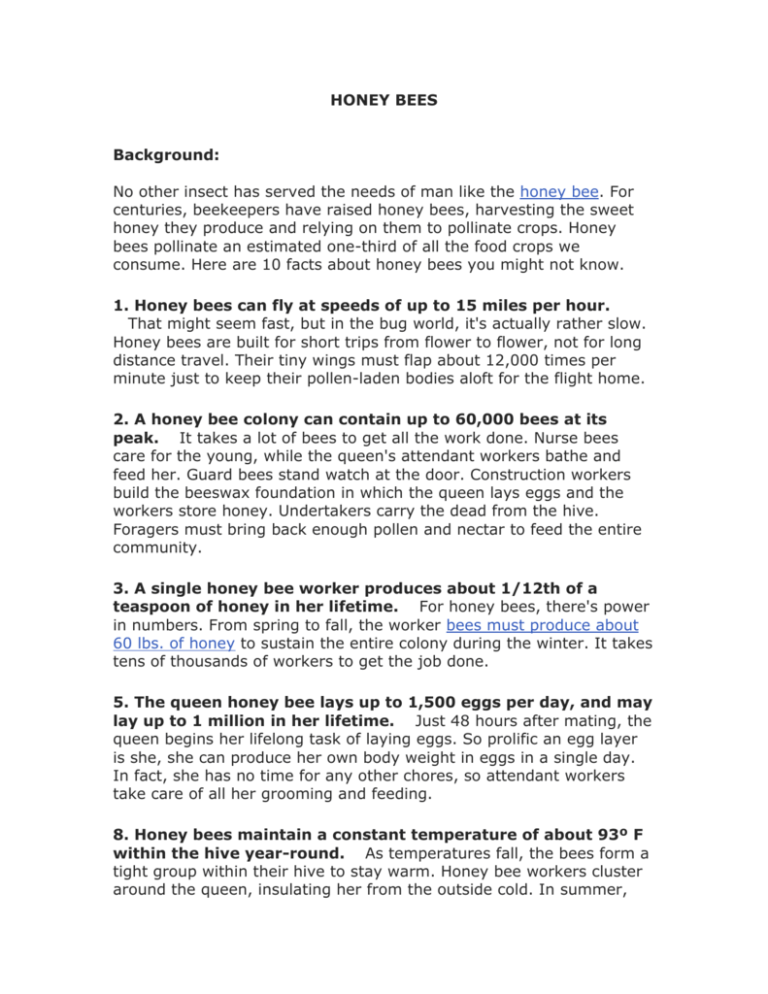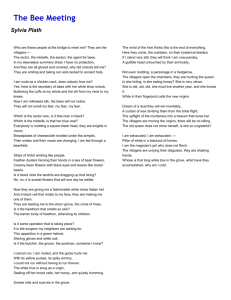HONEY BEES Background: No other insect has served the needs of
advertisement

HONEY BEES Background: No other insect has served the needs of man like the honey bee. For centuries, beekeepers have raised honey bees, harvesting the sweet honey they produce and relying on them to pollinate crops. Honey bees pollinate an estimated one-third of all the food crops we consume. Here are 10 facts about honey bees you might not know. 1. Honey bees can fly at speeds of up to 15 miles per hour. That might seem fast, but in the bug world, it's actually rather slow. Honey bees are built for short trips from flower to flower, not for long distance travel. Their tiny wings must flap about 12,000 times per minute just to keep their pollen-laden bodies aloft for the flight home. 2. A honey bee colony can contain up to 60,000 bees at its peak. It takes a lot of bees to get all the work done. Nurse bees care for the young, while the queen's attendant workers bathe and feed her. Guard bees stand watch at the door. Construction workers build the beeswax foundation in which the queen lays eggs and the workers store honey. Undertakers carry the dead from the hive. Foragers must bring back enough pollen and nectar to feed the entire community. 3. A single honey bee worker produces about 1/12th of a teaspoon of honey in her lifetime. For honey bees, there's power in numbers. From spring to fall, the worker bees must produce about 60 lbs. of honey to sustain the entire colony during the winter. It takes tens of thousands of workers to get the job done. 5. The queen honey bee lays up to 1,500 eggs per day, and may lay up to 1 million in her lifetime. Just 48 hours after mating, the queen begins her lifelong task of laying eggs. So prolific an egg layer is she, she can produce her own body weight in eggs in a single day. In fact, she has no time for any other chores, so attendant workers take care of all her grooming and feeding. 8. Honey bees maintain a constant temperature of about 93º F within the hive year-round. As temperatures fall, the bees form a tight group within their hive to stay warm. Honey bee workers cluster around the queen, insulating her from the outside cold. In summer, the workers fan the air within the hive with their wings, keeping the queen and brood from overheating. You can hear the hum of all those wings beating inside the hive from several feet away. 9. Honey bees produce beeswax from special glands on their abdomens. The youngest worker bees make the beeswax, from which workers construct the honeycomb. Eight paired glands on the underside of the abdomen produce wax droplets, which harden into flakes when exposed to air. The workers must work the wax flakes in their mouths to soften them into a workable construction material. 10. An industrious worker bee may visit 2,000 flowers per day. She can't carry pollen from that many flowers at once, so she'll visit 50-100 flowers before heading home. All day long, she repeats these round trip flights to forage, which puts a lot of wear and tear on her body. A hardworking forager may live just 3 weeks. 6. The honey bee uses the most complex symbolic language of any animal on earth, outside of the primate family. Honey bees pack a million neurons into a brain that measures a mere cubic millimeter, and they use every one of them. Worker bees must perform different roles throughout their lives. Foragers must find flowers, determine their value as a food source, navigate back home, and share detailed information about their finds with other foragers. Karl von Frisch received the Nobel Prize in Medicine in 1973 for cracking the language code of honey bees – the waggle dance. The forager bee who found the food does the round dance if food is close. The faster it dances, the closer the food. The other bees use the scent from the pollen on the forager bee to determine what kind of plant the forager bee found. The waggle dance is used to communicate the location of food sources more than 35 yards away. The dance consists of two loops with a straight run in the middle. The bees waggle (or shake) while they dance. The direction of the straight run determines the direction of the food source. The rate of looping and duration of buzzing indicate the distance to the food supply. The faster the bee's rate of looping, the closer the food supply. The longer the bee buzzes, the farther away the food source. ACTIVITY Tell kids they are going to learn to communicate like bees. They are going to do the waggle dance. Assign 5-6 kids at a time to be the forager bees. Give them a paper flower. While the other bees cover their eyes, the foragers go and hide the flower in the garden. When they come back to the “hive,” they do the waggle dance to show the other bees where the flower is. The other bees then set off to find the flower. If they need to, they can ask the foragers to do the waggle dance again. Trade groups so everyone gets to be a forager at least once.





